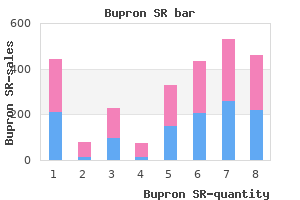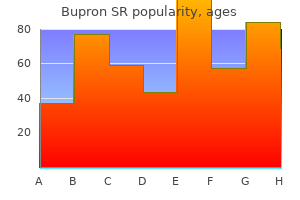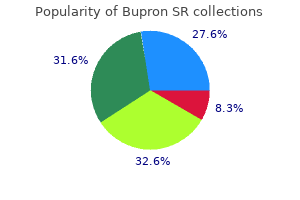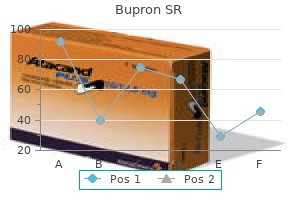

 5100 Springfield St. Suite 108, Dayton, Ohio 45431-1274
5100 Springfield St. Suite 108, Dayton, Ohio 45431-1274Bupron SR
"Generic 150 mg bupron sr with amex, postnatal depression definition nhs".
By: A. Tukash, M.B.A., M.B.B.S., M.H.S.
Vice Chair, Palm Beach Medical College
If early or urgent postnatal man agement is required depression test had cheap 150 mg bupron sr with visa, delivery at a centre that can provide the appropriate neonatal care should be considered depression definition icd 10 order bupron sr with american express. In cases of termination of pregnancy depression symptoms 12 year old discount bupron sr 150 mg amex, stillbirth or neonatal death, the health professional should encourage the per formance of a complete postmortem by a perinatal pathologist to provide maximum information about the fetal anomaly. When a complete postmortem is refused, at least a partial or external postmortem (including Xrays and photographs) should be considered. Firstly, it is crucial to remember that to the pregnant woman the detection of any anomaly is a source of great anxiety and stress. Women should receive information regarding the abnormal ultrasound findings in a clear, sympathetic and timely fashion, and in a sup portive environment that ensures privacy. A full and frank discussion with a senior obstetrician or fetal medicine specialist is important for explaining the diagnosis and further management of the pregnancy. Counselling should be nondirective, sympathetic and wherever possible should include a paediatric specialist. For some conditions termination of pregnancy is an option but it must be broached sensitively. Outcomes associated with isolated agenesis of the corpus callosum: a metaanalysis. Systematic review and metaanalysis of isolated posterior fossa malformations on prenatal ultrasound imaging (part 1): nomenclature, diagnostic accuracy and associated anomalies. Systematic review and metaanalysis of isolated posterior fossa malformations on prenatal imaging (part 2): neurodevelopmental outcome. A review of pathophysiology and management of fetuses and neonates with meconium ileus for the pediatric surgeon. Abdominal wall defects: prenatal diagnosis, newborn management, and longterm outcomes. Outcome after 17 18 19 20 21 22 23 24 25 26 27 28 29 prenatal diagnosis of congenital anomalies of the kidney and urinary tract. Unilateral renal agenesis: necessity of postnatal evaluation in a contemporary series. Fetal bladder outlet obstruction: embryopathology, in utero intervention and outcome. Antenatal detection of cleft lip with or without cleft palate: incidence of associated chromosomal and structural anomalies. Improvements in the health of the population, and in particular perinatal care, have led to a reduction in over all total pregnancy complications (both maternal and perinatal). However, the proportion of these attributed to twins and higherorder pregnancies is increasing and of significant importance. Almost every maternal and obstetric problem occurs more frequently in a multiple pregnancy and there are, in addition, a number of poten tial intrapartum considerations that complicate routine management. The modern management of a multiple pregnancy initially concentrates on the recognition of fetal risk, as mediated primarily by chorionicity, and then the monitoring of fetal growth and wellbeing using ultrasound. Attempts to reduce the risks of preterm delivery and preeclampsia in the mother are equally important and equally as frustrating (as in singleton pregnancy care), with little improvement in overall management of these conditions in the last 20 years.

Currently depression test cheap 150 mg bupron sr mastercard, the use of antico agulants in women with thromboembolic disease also falls within this category depression gene test quality bupron sr 150mg. This most com monly occurs at the extremes of reproductive age (adolescence and perimenopause) depression symptoms pictures cheap 150mg bupron sr visa. Women in this group often report menstrual cycles that extend beyond 38 days or vary by more than 21 days. Endometrial dysfunction Inevitably, there are pathologies that do not easily fit within the categories described. Data exist to support an association between chronic endometrial infection and abnormal uterine bleeding, both intermen strual and heavy bleeding [5]. This is confounded by the fact that 85% of cases of chlamydial infection are asymptomatic. When they occur in the uterus they have been associated with episodes of acute excessive bleeding. These vascular lesions of the uterus pose difficult management decisions and may present with heavy uterine bleeding following early pregnancy loss. Hypoxia, inflammation, haemostasis and angiogenesis all play crucial roles in the shedding and subsequent scarless repair of the functional upper layer of the endometrium. Intermenstrual bleeding and postcoital bleed ing are suggestive of an anatomical cause whereas associ ated pressure symptoms, including bowel and urinary symptoms, may indicate the presence of a large fibroid(s). A coagulation disor der is likely if there is: 1) a history of excessive bleeding since menarche, post partum haemorrhage, surgeryrelated bleeding, or bleeding associated with dental work; or 2) a history of two or more of (i) bruising greater than 5 cm, (ii) epistaxis once a month, (iii) frequent bleed ing or (iv) a family history of bleeding symptoms. Examination A general evaluation of the patient should be performed to exclude signs of anaemia, evidence of systemic coagu lopathy. An abdominal examination should be per formed to reveal a pelvic mass (eg, fibroid); a speculum examination should be performed to assess the vulva, vagina and cervix (this may reveal sources of bleeding, such as a tumour, or a discharge suggesting infection); and a bimanual examination should be performed to elicit uterine enlargement. In older women, and in younger women in whom medical treatment has failed, further investigation is warranted (Table 48. Published research has provided the clinician with highquality data regard ing the accuracy of pelvic ultrasound and outpatient hys teroscopy in the diagnosis of structural lesions. This imaging modality will assist in further identi fication and localization of fibroids and also features of adenomyosis if present. Antifibrinolytics Antifibrinolytics, such as tranexamic acid, reduce blood loss by up to 50% by inhibiting endometrial fibrinoly sis [12]. As its action is local, progestogenrelated side effects are much less than with oral agents. However, women should be fully counselled that they are likely to experience unscheduled spotting/bleeding during the initial months of use. Mefenamic acid is the most fre quently used agent and reduces blood loss by approxi mately 25% [13]. The drug is taken during menstruation and has the advantage of additional analgesic properties. Cyclical administration of progestogens for less than 21 days each cycle in ovulatory women is of no benefit. Shorter courses of oral progestogens (14 days) are appropriate for women with definite anovulatory cycles. It reduces bleeding by around 50% and has the additional benefit of reducing dysmen orrhea.

Together with the sacrotuberous ligament and the bony pelvis anxiety coping skills purchase 150mg bupron sr with amex, it forms the borders of the greater sciatic foramen (through which the sciatic nerve passes) and the lesser sciatic foramen (through which the pudenal nerve enters the pelvis) depression symptoms miscarriage buy bupron sr pills in toronto. This is a synovial joint and is supported by the posterior and interosseous sacroiliac ligaments depression symptoms extreme anger buy bupron sr 150mg on-line. The symphysis pubis is a cartilaginous joint with a fibrocartilaginous disc separating the two bones, which are firmly bound together by the supporting ligaments. Anteriorly they come together to form the prepuce of the clitoris and posteriorly they form the fourchette. It usually has a small opening in virgins and is only seen as an irregular remnant in sexually active women. The vulval blood supply comes from the pudendal artery and lymphatic drainage is through the inguinal lymph nodes. The nerve supply comes mostly from the pudendal nerve and pelvic plexus, with branches of the perineal nerves and posterior cutaneous nerve of the thigh important in the posterior region. The clitoris the clitoris corresponds to the male penis and consists of the same three masses of erectile tissue. The bulb of the vestibule is attached to the underlying urogenital diaphragm and splits into two because of the Pelvic floor the obturator internus muscle sits on the medial side of the ischial bone and, together with the body of the pubis, forms a wall that supports the origins of the pelvic floor. Tip of coccyx Greater trochanter of femur Symphysis pubis Iliopectineal line Pubic crest Pubic tubercle. Promontory of sacrum Sacrotuberous ligament Pelvic inlet Sacrospinous ligament Body of pubis Tip of coccyx Pubic arch Pelvic outlet Ischial tuberosity the pelvic floor itself is a sling of various muscles that are pierced by the urethra, the vagina and the anal canal. The puborectalis muscle forms a sling around the junction of the anus and rectum and posterior to the anus, and these fibres consist of the pubococcygeus that forms the anococcygeal body in the midline. The collection of muscles is variously referred to as the Clinical Anatomy of the Pelvis and Reproductive Tract 481. Levator prostate or sphincter vaginae Puborectalis Pubococcygeus Symphysis pubis Perineal body Junction of rectum and anal canal Anococcygeal body lliococcygeus Tip of coccyx Coccygeus. Sacrotuberous ligament Linear thickening of fascia covering obturator internus muscle Ischial spine Coccyx Obturator canal Obturator internus muscle Coccygeus muscle Levator ani muscle pelvic diaphragm or levator ani muscles. These muscles support the pelvic organs, holding them in position and resisting the forces created when the intraperitoneal pressure is raised as in coughing or straining. It pierces the pelvic floor and then lies flat on its posterior surface using it as support. It is approximately 8 cm long and the anterior and posterior walls oppose each other. Anatomical textbooks can give a confusing impression when showing this structure as an open tube with a lumen. However, on imaging, the normal vagina should not be distended and does not contain air. The areas of the vagina that border the cervix are referred to as the fornices and are labelled as anterior, posterior, right or left. The vaginal wall consists of outer and inner circular layers of muscles that cannot be distinguished from each other. The epithelium contains no glands but is rich in glycogen in the premenopausal woman. The normal commensal, Lactobacillus acidophilus, breaks down this glycogen to create an acid environment. Uterus the uterus is approximately the size and shape of a pear with a central cavity and thick muscular walls. The serosal surface is the closely applied peritoneum, beneath which is the myometrium. The myometrium is smooth muscle supported by connective tissue and comprises three layers of muscle: external, intermediate and internal layers.

Signs can be subtle and fetal heart abnormalities in the presence of a uterine scar should be taken extremely seriously and rarely depression unspecified icd 10 purchase bupron sr overnight delivery, if ever bipolar depression famous people purchase 150 mg bupron sr, justify fetal blood sampling kaiser depression test purchase bupron sr 150mg otc. Similarly, a multiparous patient with secondary arrest should arouse suspicion, and Syntocinon augmentation should only be decided after careful clinical assessment of the patient by the obstetrician to exclude obstructed labour. Emergency obstetric deliveries Most emergency operative deliveries (caesarean section, instrumental delivery, breech and twin deliveries and interventions for fetal distress) together with neonatal resuscitation are mentioned in the relevant chapters, but the management of shoulder dystocia and cord prolapse is illustrated in Figs 25. Always remember that the problem is at the pelvic brim and pulling on the baby or pushing down on the fundus are both unhelpful and dangerous. Time is deceptive and what feels like a lifetime is only a few minutes (try to glance at a clock or get someone to note timings). Obstetric Emergencies Shoulder dystocia: Describes difficulty delivering the shoulders Is due to a problem at the pelvic inlet Mechanism of shoulder dystocia and how to overcome it Cause: Diagnosis: Anterior shoulder of the baby is wedged above the pubic symphysis Posterior shoulder is usually in the pelvis Failure of head to restitute Turtles sign If still unrecognized then difficulty delivering the shoulders ensues 349 Anticipated difficulty with shoulders after recognizing risk factors Macrosomia Maternal diabetes/obesity/excess weight gain Post-dates pregnancy Dystocia (esp. There remains a place for cephalic replacement [54] and occasionally symphysiotomy can be lifesaving [55]. Check if the posterior shoulder is still above the pelvic brim or has entered into the pelvis and can be felt in the sacral hollow to help decide which of these manoeuvres would best suit. If an operative vaginal delivery is proposed, it should be simple and achieved quickly; if it is not, it should be abandoned early. Obstetric Emergencies 351 If there is no fetal bradycardia this need not be a panic delivery under general anaesthesia, and regional block administered with the patient lying on her side may be appropriate. If the bladder has been filled with saline, remember to empty it before surgery (just removing the spigot from the Foley catheter is not sufficient). Summary Good antenatal care, anticipating possible problems and preparing for them, and running a wellcoordinated delivery suite are the mainstays of coping with obstetric emergencies. Training and drills help to focus on teamwork and provide a supportive system to reduce adverse consequences. In any obstetric emergency keep the basic pathology in mind: why has this happened, what is the problem and how can it be treated The Eigth Report on Confidential Enquiries into Maternal Deaths in the United Kingdom. Reducing risk in maternity by optimising teamwork and leadership: an evidencebased approach to save mothers and babies. Clinical efficiency in a simulated emergency and relationship to team behaviours: a multisite crosssectional study. Teamwork for clinical emergencies: interprofessional focus group analysis and triangulation with simulation. What is the impact of multiprofessional emergency obstetric and neonatal care training Improving neonatal 19 20 21 22 23 24 25 26 27 28 29 30 31 outcome through practical shoulder dystocia training. Management of massive postpartum haemorrhage: use of a hydrostatic balloon catheter to avoid laparotomy.

However depression era definition buy bupron sr without a prescription, these studies showed that nearly one in five attempts to remove polyps (detach and retrieve in entirety) failed primarily because of inadequate visualization fayum depression definition order 150mg bupron sr visa, patient intolerance or difficulties in retrieval from the uterine cavity down the relatively narrow endocervical canal depression black flag cheap bupron sr online visa. The introduction of tissue removal systems (formerly referred to as hysteroscopic morcellators) with their inherent ability to simultaneously cut and aspirate polyp tissue has overcome these obstacles. A recent rand omized controlled trial comparing the TruClear system with the Versapoint Bipolar Electrosurgical System in an outpatient setting demonstrated lower failure rates (<2% vs. Myomectomy Submucous fibroid(s) that are entirely within the cavity are classified as type 0. If a portion of the fibroid is intramural, then they are classified as type 1 if less than 50% is intramural and type 2 if more than 50% is intra mural [31]. In contrast, removal of type 2 fibroids is more challenging because risks of perioperative bleeding, incomplete removal and uterine trauma are significantly greater. Furthermore, the requirements for repeated hysteroscopic or other surgical interventions are greater to treat ongoing abnormal bleeding symptoms compared with type 0 and 1 fibroids [34]. Ambulatory Gynaecology, Hysteroscopy and Laparoscopy 531 Whilst most operative hysteroscopic procedures described in this chapter are feasible in an outpatient set ting, removal of submucous fibroids generally requires general/regional anaesthesia. The Versapoint electrode can rapidly excise nonfundal grade 0 fibroids although retrieval down the narrow cervical canal, even under general anaesthesia, can be difficult. Moreover, grade 1 and 2 fibroids cannot be resected by point electrodes and for this reason hysteroscopic removal is mostly done with resectoscopes utilizing cutting loop electrodes. Advanced hysteroscopic skills are required and an appro priate caseload to maintain surgical proficiency. These hysteroscopic firstgeneration tech niques of endometrial destruction have been superseded to some extent by the newer secondgeneration ablative techniques which are technically easier to perform and associated with comparable clinical outcomes and fewer complications [37]. The development of miniature secondgeneration, semiautomated ablative technologies has allowed the concept of outpatient local anaesthetic endometrial ablation to progress. The majority of women undergo ing the procedure in the outpatient setting find it acce ptable [38]. Metroplasty the most common congenital uterine anomaly amena ble to hysteroscopic treatment is the partial or complete uterine septum (septoplasty). The fibroelastic tissue comprising a uterine septum can be divided mechani cally using scissors, with electrosurgery (Versapoint electrode or resectoscopic division using a Collins knife electrode) or a combination of mechanical and electro surgical techniques. Other uteroplastic procedures have been reported including restoration of the shape of a hypoplastic or Tshaped uterus by scoring the myome trium with activated miniature bipolar electrodes in an attempt to increase the uterine capacity [39]. Bipolar electrodes can also be used to create outflow channels in noncommunicating rudimentary uterine horns. Hysteroscopy is the gold standard for accurate diagnosis and assessment of intrauterine adhesions. Hysteroscopic techniques include blunt or sharp adhesiolysis, using mechanical or electrosurgical instruments. In some patients, landmarks remain obscure and entry into the uterus may not be possible by hysteroscopy alone. In these patients it is necessary to perform simultaneous laparoscopy, fluoroscopy or ultrasound to reduce the risk of perforation. Increased uterine cavity size can be achieved by myometrial scoring with scissors or a Collins knife electrode [39]. Proximal fallopian tube cannulation Tubal catheterization is a technique used to treat a proxi mal fallopian tube blockage diagnosed following a hys terosalpinogram.
Order 150mg bupron sr otc. Emotional states in ADHD Bipolar Disorder and ODD.